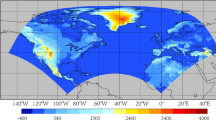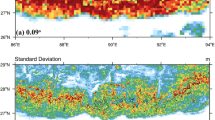Abstract
With increasing resolution in numerical weather prediction (NWP) models, the model topography can be described with finer resolution and includes steeper slopes. Consequently, negative effects of the traditional terrain-following vertical coordinate on high-resolution numerical simulations become more distinct due to larger errors in the pressure gradient force (PGF) calculation and associated distortions of the gravity wave along the coordinate surface. A series of numerical experiments have been conducted in this study, including idealized test cases of gravity wave simulation over a complex mountain, error analysis of the PGF estimation over a real topography, and a suite of real-data test cases. The GRAPES-Meso model is utilized with four different coordinates, i.e., the traditional terrain-following vertical coordinate proposed by Gal-Chen and Somerville (hereinafter referred to as the Gal.C.S coordinate), the one-scale smoothed level (SLEVE1), the two-scale smoothed level (SLEVE2), and the COSINE (COS) coordinates. The results of the gravity wave simulation indicate that the GRAPES-Meso model generally can reproduce the mountain-induced gravity waves, which are consistent with the analytic solution. However, the shapes, vertical structures, and intensities of the waves are better simulated with the SLEVE2 coordinate than with the other three coordinates. The model with the COS coordinate also performs well, except at lower levels where it is not as effective as the SLEVE2 coordinate in suppressing the PGF errors. In contrast, the gravity waves simulated in both the Gal.C.S and SLEVE1 coordinates are relatively distorted. The estimated PGF errors in a rest atmosphere over the real complex topography are much smaller (even disappear at the middle and upper levels) in the GRAPES-Meso model using the SLEVE2 and COS coordinates than those using the Gal.C.S and SLEVE1 coordinates. The results of the real-data test cases conducted over a one-month period suggest that the three modified vertical coordinates (SLEVE1, SLEVE2, and COS coordinates) give better results than the traditional Gal.C.S coordinate in terms of forecasting bias and root mean square error, and forecasting anomaly correlation coefficients. In conclusion, the SLEVE2 coordinate is proved to be the best option for the GRAPES-Meso model.
Similar content being viewed by others
References
Anther, R. A., and T. T, Warner, 1978: Development of hydrodynamic models suitable for air pollution and other meso-meteorological studies. Mon. Wea. Rev., 106, 1045–1078.
Chen Dehui, Xue Jishan, Yang Xuesheng, et al., 2008: New generation of multi-scale NWP system (GRAPES): General scientific design. Chin. Sci. Bull., 53, 3433–3445.
Gal-Chen. T. J., and R. C. Somerville, 1975: On the use of a coordinate transformation for the resolution of the Navier-Stokes equation. J. Comput. Phys., 17, 209–228.
Klemp, J. B., 2011: A terrain-following coordinate with smoothed coordinate surfaces. Mon. Wea. Rev., 139, 2163–2169.
Li Chao, Li Xingliang, and Chen Dehui, 2012a: Impact of height-based terrain-following coordinates on a case of heavy rain simulations. Torrential Rain and Disasters, 10, 358–368. (in Chinese)
Li Chao, Chen Dehui, and Li Xingliang, 2012b: On design of a height-based terrain-following coordinates in the atmospheric numerical model: Theoretical analysis and idealized tests. Acta Meteor. Sinica, 70, 1247–1259. (in Chinese)
Phillps, N. A., 1957: A coordinate system having some special advantages for numerical forecasting. J. Meteor., 14, 184–185.
Qian Yongfu and Zhou Tianjun, 1995: Modeling tests of the error sub-traction scheme for the pressure gradient force in models with topography. Plateau Meteor., 14, 1–9.
Schär, C., D. Leuenberger, O. Fuhrer, et al., 2002: A new terrain-following vertical coordinate formulation for atmospheric prediction models. Mon. Wea. Rev., 130, 2459–2480.
Smith, R. B., 1979: The influence of mountains on atmosphere. Adv. Geophys., 21, 87–230.
Smith, R. B., 1980: Linear theory of stratified hydrostatic flow past an isolated mountain. Tellus, 32, 348–364.
Xue Jishan, Chen Dehui, et al., 2008: The Scientific Design and Application of NWP System GRAPES. Science Press, Beijing, 67 pp. (in Chinese)
Ye Duzheng, et al., 1979: The Qing Zang Plateau Meteorology. Science Press, Beijing, 179 pp. (in Chinese)
Zdunkowski, W., and A. Bott., 2003: Dynamics of the Atmosphere: A Course in Theoretical Meteorology. Cambridge University Press, 719 pp.
Author information
Authors and Affiliations
Corresponding author
Additional information
Supported by the National (Key) Basic Research and Development (973) Program of China (2013CB430106), National Natural Science Foundation of China (41375108), and National Science and Technology Support Program of China (2012BAC22B01).
Rights and permissions
About this article
Cite this article
Li, C., Chen, D., Li, X. et al. Effects of terrain-following vertical coordinates on high-resolution NWP simulations. J Meteorol Res 29, 432–445 (2015). https://doi.org/10.1007/s13351-015-4212-x
Received:
Accepted:
Published:
Issue Date:
DOI: https://doi.org/10.1007/s13351-015-4212-x




